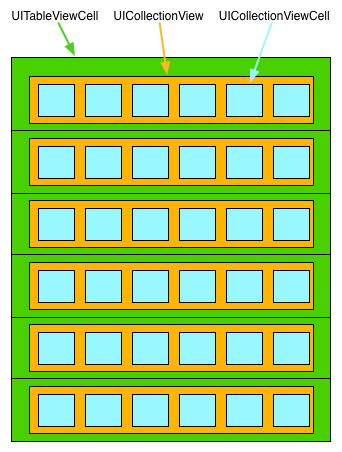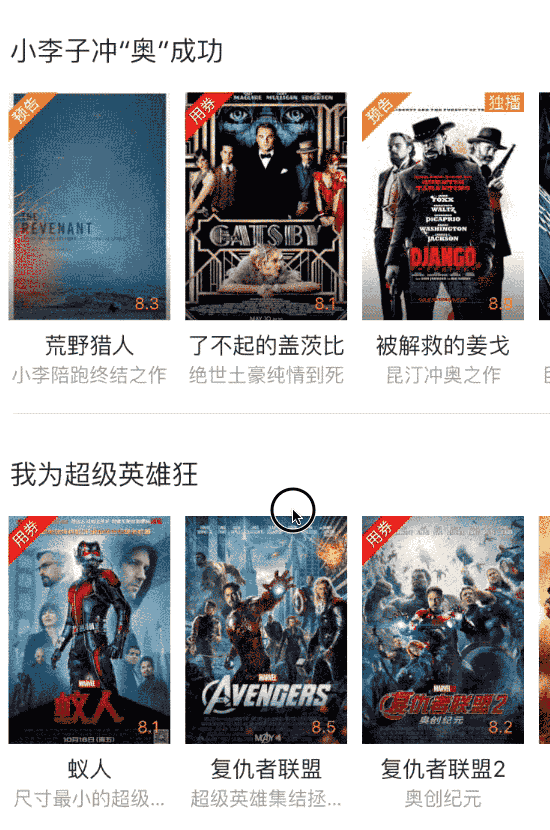问题描述
UIViewController 中有一个 UITableView,UITableViewCell 的 contentView 上添加了横滑列表,横滑列表是用 UICollectionView 实现的。
如下图所示

抽象出来就是这样

其中 UITableView 的 DataSource/Delegate 是 Controller,而 UICollectionView 的 DataSource/Delegate 是 UITableViewCell。
UITableView 的 DataSource 抽象如下:
- (UITableViewCell *)tableView:(UITableView *)tableView cellForRowAtIndexPath:(NSIndexPath *)indexPath
{
JceObject *cellObj = [_dataModel.aryItems objectAtIndex:indexPath.row];
UITableViewCell *cell = [QLThumbsMgr makeCellWithJCEPoster:cellObj tableView:tableView userInfo:self];
return cell;
}
好像看似没什么问题是吧,UITableView 的使用一向都是这样的嘛。可是当 UITableViewCell 碰上了 UICollectionView,问题就出来了。
左右滑动一个 UICollectionView 使其 contentOffset 不为初始值,再上下滑动 UITableView,你会发现,其他的横滑列表也被横滑了,上个动图直观感受一下

问题分析
如果对于 UITableView 的 Cell 复用机制有一定了解的同学一定很容易看出问题,就是因为 Cell 之间的复用导致了 UICollectionView 的 contentOffset 也被复用了。
那么之前我们是如何解决 UITableViewCell 的复用问题呢?就是每次 Cell 出现的时候,就根据数据源更新 Cell 的内容,这样就保证了每次看到的 Cell 是正确的。
但是现在棘手的是数据源中并没有包含 UICollectionView 的 contentOffset。
问题可以转化为如何在 UITableViewCell 出现的时候,更新其 UICollectionView 的 contentOffset。依赖 UITableViewCell 去记住是行不通的,因为它自己就是被复用的对象,那么就要外部去帮它记住,这个外部可以是 UITableView 的 Delegate——UIViewController,也可以 UITableViewCell 的数据源。
如果是数据源,则需要对数据源做一个扩展 or 分类,由于数据源与前后台协议是相关的,改动数据源或许不是一个好的选择。所以这里我选择了让 UIViewController 去完成这个记忆的任务。
解决方法
我们可以为 UIViewController 添加一个 NSMutableDictionary 类型的实例变量,该字典存储的是 UITableViewCell 的位置和其 UICollectionView 的横滑位置的映射关系。
UITableViewCell 即将从视野里消失的时候,UIViewController 用 NSMutableDictionary 记录该 Cell 的 indexPath.row 和其 UICollectionView 的 contentOffset;(这里只讨论 UITableView 只有一个 section 的情况,多个 section 的处理原理是一样的)
UITableViewCell 即将出现在视野里的时候,UIViewController 根据该 Cell 的 indexPath.row,从 NSMutableDictionary 中读取相应的值去设置该 Cell 上的 UICollectionView 的 contentOffset;
UIViewController 是 UITableView 的 Delegate,UITableViewCell 的出现和消失事件可以在以下2个代理方法中捕捉到。- (void)tableView:(UITableView *)tableView willDisplayCell:(UITableViewCell *)cell forRowAtIndexPath:(NSIndexPath *)indexPath;
和- (void)tableView:(UITableView *)tableView didEndDisplayingCell:(UITableViewCell *)cell forRowAtIndexPath:(NSIndexPath*)indexPath;
那么,UIViewController 中的代码应该类似这样。
- (void)tableView:(UITableView *)tableView willDisplayCell:(UITableViewCell *)cell forRowAtIndexPath:(NSIndexPath *)indexPath
{
if ([cell isKindOfClass:[QLONAListCell class]])
{
QLONAListCell *listCell = (QLONAListCell *)cell;
NSInteger row = indexPath.row;
CGFloat horizontalOffset;
horizontalOffset = [self.contentOffsetDict[[@(row) stringValue]] floatValue];
[listCell.horizontalScrollView setContentOffset:CGPointMake(horizontalOffset, 0)];
}
}
- (void)tableView:(UITableView *)tableView didEndDisplayingCell:(UITableViewCell *)cell forRowAtIndexPath:(NSIndexPath *)indexPath
{
if ([cell isKindOfClass:[QLONAListCell class]])
{
QLONAListCell *listCell = (QLONAListCell *)cell;
NSInteger row = indexPath.row;
CGFloat horizontalOffset = listCell.horizontalScrollView.contentOffset.x;
self.contentOffsetDict[[@(row) stringValue]] = @(horizontalOffset);
}
}
其中 QLONAListCell 是 UITableViewCell 的子类,它有一个 UICollectionView 类型的属性 horizontalScrollView。
contentOffsetDict 是 UIViewController 的实例变量,它是一个 NSMutableDictionary。
哦,还有一个注意点。当对 UITableView 进行下拉刷新的时候,新数据可能与老数据不一样(比如多了某个 Cell 或少了某个 Cell),那么这种情况下,contentOffsetDict 的记录就不再正确,所以每次在数据请求回来的时候,最好清空一下 contentOffsetDict。这样做的后果就是每次下拉刷新就会清空横滑列表的 contentOffset,不过看起来也似乎合情合理。


